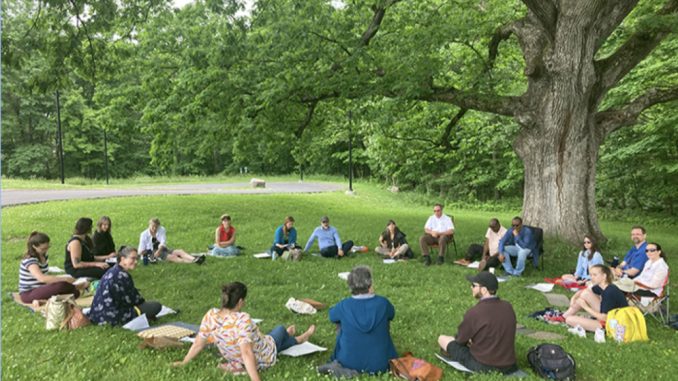
SUNY New Paltz announced the university received a Gold Level Rating in the Sustainability Tracking, Assessment & Rating System (STARS) on Sept. 13. This rating comes from the Association for the Advancement of Sustainability in Higher Education (AASHE), making New Paltz the second comprehensive university in the SUNY system to receive such a rating for sustainability efforts on campus.
STARS is self-defined as a “transparent, self-reporting framework for colleges and universities to measure their sustainability performance.” Systems such as the AASHE are then able to provide a benchmarking system in order to systematically measure sustainability and designate campuses to certain “levels.” To receive a Gold Level standard, New Paltz showed advancements and success in multiple criteria all pertaining to sustainability. Cross-sector observations like STARS ratings help to identify a comprehensively sustainable campus as opposed to multiple independently successful systems within a campus.
These ratings include Reporter, Bronze, Silver, Gold and Platinum. New Paltz had previously received Silver ratings first in 2015 and then was approved for renewal in 2018. The most recent rise to Gold level credits not one effort or department, but instead a widespread, dedicated movement across campus to improve sustainability overall.
STARS ratings pertain to schools on all levels, as the system “encompasses long-term sustainability goals for already high-achieving institutions, as well as entry points of recognition for institutions that are taking first steps toward sustainability.” For New Paltz, this meant advancing past Silver standards to reach Gold through campus-wide, effective and long-term sustainability efforts proven to the AASHE.
Combined efforts between the Sustainability Faculty Learning Community and the Sustainability Ambassador Program, explained by Campus Sustainability Coordinator Lisa Mitten, were strong points in pushing New Paltz to Gold Level STARS rating recently. The Sustainability Faculty Learning Community involves 15 academics and professionals. The program entails joining a cohort program for one year, developing a community, learning about approaches and sustainability frameworks and solutions. Learnings are then integrated into disciplines and curriculum. There are now 53 faculty members who conduct sustainability research, a leap from the 24 on campus in 2015.
Mitten identified the second major program on campus leading sustainability efforts as the Sustainability Ambassador Program. With 36 members, this year’s group is the largest cohort in program history. Students in the program choose a specific team with a certain vision for campus sustainability and then work to identify strategies to achieve such goals. This is done by partnering with campus employees to work together to find sustainable solutions and implement sustainability solutions on campus. Both the ambassador and faculty learning programs place efforts in uniting campus efforts to achieve sustainability, which has proven the most effective method in reaching goals and seeing results.
Gold Level rating, while critical in a campus’s mission to be sustainable, is not an end goal in the slightest. Mitten explained how one of the sustainability program’s biggest challenges going forward will be “figuring out and implementing strategies to decarbonize and get off fossil fuels.” Presently, campus heating systems rely primarily on natural gas. The Clean Energy Master Plan, which is soon to be completed, suggests some pathways for the campus to move away from fossil fuels. These alternatives include ground source, air source, heat pumps and thermal storage. Mitten explained “one of our biggest challenges as a campus is to figure out how to fund such initiatives, and then how to plan, design, construct and operate that transformation of our built environment.”
Andrea Varga, Associate Professor of Theatre Design and Sustainability Faculty Fellow, expressed how there is a need for interconnectedness and deliberate actions across departments. “I think we have an incredible opportunity to tell this story together in a way that just makes us all healthier,” done via hands-on approaches to witnessing sustainability as well as more effective communication to enhance awareness of various areas on campus with different purposes but similar goals of sustainability.
“Sustainability is everything,” explained Varga. “There’s nothing more critical that we could be doing than thinking of how we integrate sustainability into every part of our lives, and how we think about our existence and responsibility toward each other, on this earth, and toward all of the living systems.”
The future of the sustainability program looks toward greater integration of all departments into a more unified effort. Assistant Vice President for Facilities and Operations Gail Beltrone explained the need for concentrated efforts across all sectors of campus. “The Office of Campus Sustainability, and by extension, the Facilities Department cannot do everything that needs to be done.” Growth in the future and campus commitment requires consideration of sustainability from “every functional area,” ranging from residence halls to departmental buildings.
“College campuses cultivate the next generation of leaders and resource users.” And, Beltrone explained, working sustainability into all aspects of campus is not only the future for New Paltz sustainability efforts, but also the present movement. Acknowledging individuals in all campus positions–from students to academic leadership–as functional and critical parts of reaching sustainability is the first step. Following that, sustainability efforts will pertain to the campus culture as a whole
This contributes to the notion that sustainability is not a contained concept, but instead a far-reaching initiative. Incorporating sustainable awareness and actions into education is a step right in line with pushing sustainable agendas onto functional systems on campus as well as overall culture on campus.
Varga explained that commitments to sustainability are critical to New Paltz considering the location, history and campus culture of the university. “It holds us accountable to our ethos, as a school in a place that cares about nature and art and culture and learning and science and community. It holds us accountable because now we can say we’re doing it in the twenty-first century in a way that isn’t just resting on the past, but going into the future.”
